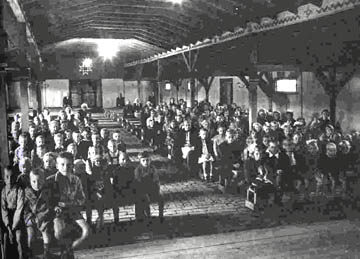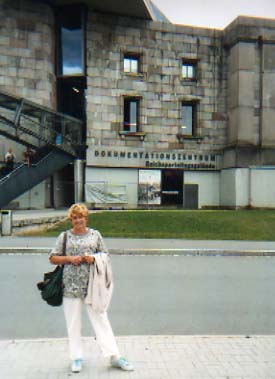View of bombed out Nuernbuerg onto the Main market about 1945. All the roofs are gone and only some walls are standing. You've got to imagine how terrified the residents and slave labor were during all this bombing.
City archives: Stadtarchiv  Marientorgraben 8
Marientorgraben 8
90402 Nürnberg
Tel: 09 11 - 2 31 27 70
Fax: 09 11 - 2 31 40 91
http://www.stadtarchiv.nuernberg.de/
State archives: Staatsarchiv Nürnberg,
Archivstr. 17,
90408 Nürnberg,
In June 1945, there were still 13,300 DPs accommodated in Nürnberg, of which over half, i.e., 8,500 were registered as staying in the former SS-Barracks, where the Americans fed and nursed many back to health after their ordeal of hard labour, poor nutrition and inadequate medical attention.
In September 1945, there remained between 5,000-6,000 'foreigners' in the SS-Barracks waiting to return to their homelands. Eventually by 18th December 1946, the town council decided to release the building for city administration purposes but this was opposed by the US Military, which decided to use the SS-Barracks to create a US Garrison there.
In 1946 on the area of the former prisoner-of-war camp at Nürnberg-Langwasser (which had operated under the German armed forces from 1939 to 1945 near the Reichs Party Congress area), the Americans set up a DP camp under the administration of the UNRRA (United Nations Relief and Rehabilitation Administration) for the accommodation of homeless foreigners (Displaced Persons). The occupants were mainly Latvian and others from the Baltic states. The large majority of which had emigrated overseas. The camp went by the name Valka Lager. When the International Refugee Organization (IRO) replaced the UNRRA in 1947, the camp became a major center for homeless foreigners, primarily inhabited by refugees from the Eastern Bloc countries. In October 1951, it housed 4,300 persons from 28 nations and had largest number of DPs in Bavaria.
Best regards, Stefan Mucha
The connections between church and school were usually close in the camps. These Latvian young people attended Sunday children's service at Valka camp at Nürnberg. Photo credit: Lutheran World Federation & Mark Wyman
Photos at United Nations archives: We have photo # UN22341: DP students at the Lauf Language Training Institue near Nurnberg, Germany
We have photo # UN22341: DP students at the Lauf Language Training Institue near Nurnberg, Germany
Please let me know if you would be interested in obtaining hi-res scans ($3 each) or prints ($ 7 each).
Best regards,
Clara Gouy photolibr@un.org
Photo Librarian, United Nations
Museum für Kommunikation Nürnberg
Lessingstr. 6
90443 Nürnberg
Tel.: 0911.230 88 - 0
e-mail: mk.nuernberg@t-online.de
Nürnberg firms employing forced laborers, 1939-1945
Dear Olga,
I am new to this site and find it very interesting. My parents are survivors of the holocaust, originally from Poland. We emigrated to the United States in 1951. My son is in the process of researching our geneology and I am currently looking for any sites I can access to help in his research. Specifically I would love to obtain passenger lists from the Mauretania which left Le havre, France in December 1951, My parents were slave laboreres for the entire war, with my dad having been shipped to Nuremberg concentration camp, then back to a farm for slave labor. Their long and painful journey to the United States is absolutely unbelievable. I would also like to know if there are any chat rooms for children of survivors of the holocaust since I believe we have our own set of issues to deal with. Would love to hear from everyone. Chris / USA



Olga in front of DokuCenter (Dokumentationszentrum Reichsparteitagsgelände) in Nürnberg. This is a museum dedicated to the history of the Third Reich and the Nazi Party. Olga turning gold ring for good luck on fountain fence in front of Church of Our Lady from the Franken period
6/29/07 Olga,
I stumbled on this site, thank
you! My mother, grandfather and grandmother lived at Valka
Lager (my grandmother is buried there). My mother met and married
my father (a Polish army POW) in Fischbach ( sp?) and they immigrated to the
US.
My mother's two sisters...one was in the British zone; the other in the Soviet, I am very proud of my heritage and how my parents came to a strange country with nothing but a suitcase and built a new life! I know my family is watched over...one story amazes me that when they came from Germany to MA, my mother, several months after arriving...while walking down a street in Newton MA, bumps into her Uncle...who she had lost contact with when Riga fell years before.
I am trying to find information on Polish POW units the American army used
around Nuremberg, any other sites you can recommend?
A Kalicki, email: AKalicki@aol.com